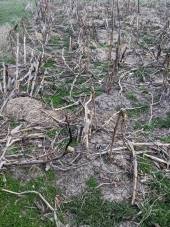
 2
2




 3
3




When you reach your lowest point, you are open to the greatest change.
-Avatar Aang
 1
1





 3
3




Hans Albert Quistorff, LMT projects on permies Hans Massage Qberry Farm magnet therapy gmail hquistorff
 3
3




'What we do now echoes in eternity.' Marcus Aurelius
How Permies Works Dr. Redhawk's Epic Soil Series
 1
1











 3
3




Hans Albert Quistorff, LMT projects on permies Hans Massage Qberry Farm magnet therapy gmail hquistorff
 3
3




James Landreth wrote:I was in a similar situation three years ago and chose to double dig. It wasn't worth it. Instead I recommend doubling down on looking for organic matter, because as you said you'll need it anyway
Are you planning on any perennials on other parts of the property?
 2
2




Hans Quistorff wrote:First step is to check the former garden area for invasive roots. some grasses will have long strings of roots that will regrow each piece of root if cut. Take a shovel and cut out a piece of sod from the proposed area and wash all the soil off of it to examine what types of roots are there. If there are no invasive roots and the soil seems rich just spading will work. Spading is simple; Remove one shovel full of sod and set it aside, the next shovel full is then dumped upside down in the hole. You only need to do the row you plan to plant at a time. the exposed soil may sprout seeds that are exposed but most of them are edible and will give you a first crop of greens as you weed. As you mow the rest of the grass use it for mulch.
This is how I restored a garden after my sister died and I inherited the farm. Some arias had invasive quack grass roots so I had to let the soil dry and sift them out.
 2
2






 3
3












 1
1




Hans Quistorff wrote: Most of our favorite foods are dependent on soil disturbance for the seeds to sprout and most of them were originally weeds so the principle of vegetable gardening is to disturb the soil and put the desired seed there. Not disturbing the soil keeps it in its natural covered state with vegetation feeding the soil microbes. Disturbing soil that is not being planted degrades the soil. That is the principle of no till.
'What we do now echoes in eternity.' Marcus Aurelius
How Permies Works Dr. Redhawk's Epic Soil Series
 2
2




Skandi Rogers wrote:You can also cheat on double digging, just flip the top spade over and bury the weeds, it won't take anything perennial but does most grasses and annual weeds. Getting mulch right now would not only be hard but irresponsible in my opinion, we need to stay away from others not go seeking them out. I personally do not use any form of mulch on my garden as hay and the like just serves as a great slug and vole habitat. I tried doing potatoes ruth stout style, they grew really well no issues.. except when I came to harvest and I got about the same as I put in as the little furry menaces had eaten everything!
When you reach your lowest point, you are open to the greatest change.
-Avatar Aang
 2
2




 4
4




 4
4








James Landreth wrote:[
Getting mulch doesn't require contact with others. It can be delivered in a dump truck. Around here there exists a field where truckers dump woodchips. You can easily go there and maintain safe social distancing practices.






 4
4




Nc Pfister wrote:Wow, Jamin, that was the most helpful reply yet! So, in short, I overturn topsoil (grass down) where I want to plant, cover with organics (or cardboard), and then just pull away the organics (or hole in cardboard) where I want to plant? I'm slow to catch on, but I think we're getting somewhere. Thanks, y'all!
 3
3




Keeping the world green, one party at a time!
http://www.YTEevents.com
(eco-friendly event decor)




 3
3




I make a Maple Syrup instructional movie! Check it out HERE
SKIP books, get 'em while they're hot!!! Skills to Inherit Property
See me in a movie building a massive wood staircase:Low Tech Lab Movie
 4
4




When you reach your lowest point, you are open to the greatest change.
-Avatar Aang
 2
2




Nc Pfister wrote:That also is very helpful, Jonathan - thank you! One question - and it feels like an unintelligent one - with your proposed method, where do I plant the seeds? Cut holes in cardboard and make a small hole in the undisturbed topsoil (which hasn't been spaded), and seed there?
I'm just struggling to visualize. Any specific YouTube videos you could point me to to help me understand this admittedly very basic component? Thanks again!
Keeping the world green, one party at a time!
http://www.YTEevents.com
(eco-friendly event decor)




 1
1











 2
2




Hans Albert Quistorff, LMT projects on permies Hans Massage Qberry Farm magnet therapy gmail hquistorff








Moderator, Treatment Free Beekeepers group on Facebook.
https://www.facebook.com/groups/treatmentfreebeekeepers/






 1
1




Some places need to be wild




 2
2


















Some places need to be wild







 4
4




Hans Albert Quistorff, LMT projects on permies Hans Massage Qberry Farm magnet therapy gmail hquistorff










 1
1




Some places need to be wild
 2
2














 1
1




Some places need to be wild














 1
1




Some places need to be wild

|
She still doesn't approve of my superhero lifestyle. Or this shameless plug:
The new gardening playing cards kickstarter is now live!
https://www.kickstarter.com/projects/paulwheaton/garden-cards
|





